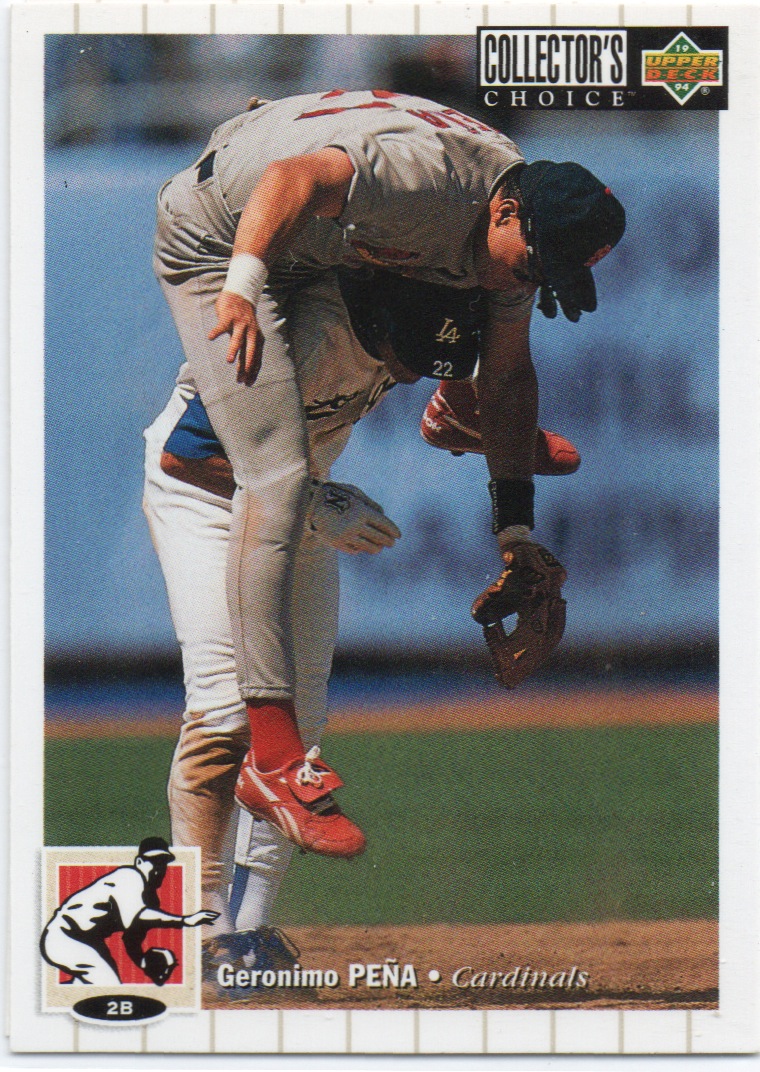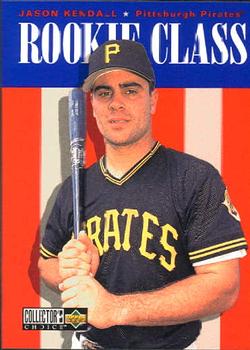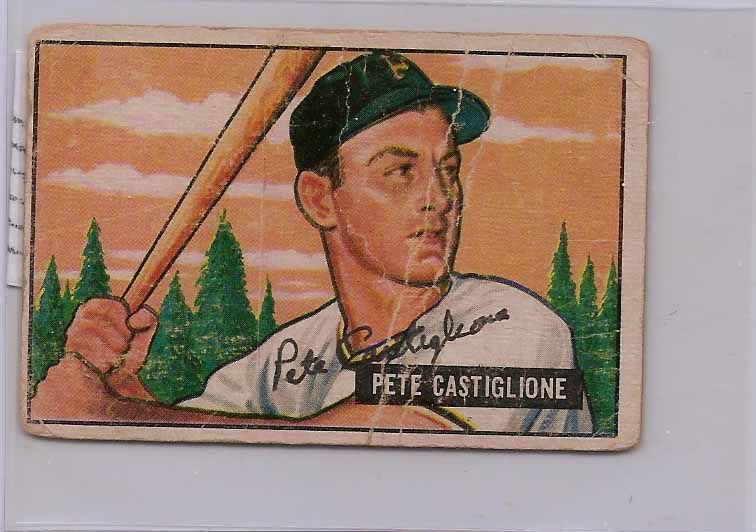To give some historical context to how the hobby structure may have changed, I'll be looking at 1998 Collector's Choice baseball. It was unquestionably a low end set primarily geared towards kids. And that strategy definitely worked.
While I had absolutely no idea who Hines Ward was in 1998, I still fondly remember pulling his rookie card out of couple packs we busted during a Cub Scouts meeting. The photo features a kid in an Upper Deck hat doing some kind of interview (real or otherwise) with Hines. And at just $1.29 a pack, it had a parent friendly price that I definitely recall making it an easy choice over pricier sets like Stadium Club.
But childhood nostalgia aside, what made the set tick? Thanks to the StarQuest Home Run insert /100, we can get a relatively good gauge for how many packs were produced. The inserts fell at 1 in 5 cases, or 1:2,160 packs. With 30 cards in the set, that makes for 3,000 cards. While Topps is known to hold back a portion of the production run today, Upper Deck typically would send hand numbered replacements for damaged cards, meaning likely all the cards were inserted. Plus in the pre-redemption days, companies didn't have to make good on cards they had promised but didn't actually produce.
Doing the quick math comes up with 6,480,000 packs of Collector's Choice baseball being pumped out in 1998. Compare that to the roughly 2,000,000 packs of 2013 Topps Chrome produced between hobby and retail.
Packs retailed for $1.29, or an inflation adjusted $1.91. A box would have ran about $45 for a 36 pack box. Markup on current products is typically between 35-40%, so assuming similar ratios in 1998 a dealer direct price would come out to about $28.50 a box.
There's no way of knowing exactly how much printing costs would have been to produce such a set. With 14 cards per pack, boxes delivered a healthy 504 cards per box. Most of the inserts were foil based like StarQuest and Crash the Game. But the base set was largely the meat of the packs. And a decent amount of care was put into the photo selection and design of the cards. They might not have had the top of the line photos, but the photography was definitely up to par with other sets of the time.
Taking an educated guess, I'd assume production costs, again before any overhead, advertising, etc, would have been in the $10 neighborhood. There isn't a ton of meat on 'them bones, but the key is in the production size.
The roughly 6,500,000 packs come out to 180,000 boxes, and 1,500 cases of product hitting shelves. I'm assuming a decent portion of that went to retail outlets that don't sell cards anymore or have a small card selection. As a kid in the mid 90's I remember every gas station and grocery store stocking at least a box or two of cards, usually headlined by the low end, kid-friendly releases. Even into 2002 or 2003 I remember Rite Aid carrying packs of $3 and under products. Now most collectors are saying that the already meager card sections in Target or Wal Mart are being eliminated or overrun with non-sport cards.
And just for a fun fact, there would be roughly 155,000 produced for each card in the 530 card base set. Amazingly enough, I can't recall finding a single one in a dime box at any point in the last few years.
So what does this all mean?
While this era can't hold a candle to the amount of wax pumped out during the early-mid 90's, there were nearly three times as many cases packed out in 1998 of a product that was definitely considered low end than we see of some of the most popular products like Topps and Bowman Chrome today.
Perhaps just as important, the added quantity would have made up quite a bit of ground financially for both the card companies and for store owners. It is worth noting that today Topps products are printed to order, so there's no way of knowing how much of that '98 CC was sitting in a warehouse unordered for the next year or two.
But this really seems to illustrate where the shifting collector population may have forced the industry's hand. Those 6 million packs were undoubtedly spread around to a wide cross-section of collectors. I doubt there were many folks who weren't big time dealers busting a case of Collector's Choice. At that price point people could afford to rip and rip and rip to get the cards they wanted, and trade or buy on the (much more limited) secondary market to get those missing cards. Today's market is much more reliant upon people who might rip a case or two of product and then are dumping 99% of those cards straight into the secondary market. When there are really only 2-3 cards in a box that even have the chance of being worth the price of the pack, there's greater incentive to buy by the box. And you can extrapolate that same logic to the case as well.
So it would be safe to assume that we'll never see those low end, low profit, high volume products again, right? At this point I'd be inclined to say yes. But there is one really interesting exception to this - Topps Opening Day. Opening Day was a pretty pathetic product for more than a decade, offering bastardized versions of Topps Flagship cards at first with foil stamping and later just with an ugly color logo. In 2006 Topps introduced numbered parallel cards, similar to the Topps gold cards. But the set was still relatively bland, and garnered little interest. But over the past few years the set has increased the presence of autographs, unique inserts, and foilboard parallels to make it one of the few products each year that truly sells out. In my third segment, I'll take a closer look at Opening Day, and discuss whether it's truly a model that other low end sets could utilize.
But childhood nostalgia aside, what made the set tick? Thanks to the StarQuest Home Run insert /100, we can get a relatively good gauge for how many packs were produced. The inserts fell at 1 in 5 cases, or 1:2,160 packs. With 30 cards in the set, that makes for 3,000 cards. While Topps is known to hold back a portion of the production run today, Upper Deck typically would send hand numbered replacements for damaged cards, meaning likely all the cards were inserted. Plus in the pre-redemption days, companies didn't have to make good on cards they had promised but didn't actually produce.
Doing the quick math comes up with 6,480,000 packs of Collector's Choice baseball being pumped out in 1998. Compare that to the roughly 2,000,000 packs of 2013 Topps Chrome produced between hobby and retail.
Packs retailed for $1.29, or an inflation adjusted $1.91. A box would have ran about $45 for a 36 pack box. Markup on current products is typically between 35-40%, so assuming similar ratios in 1998 a dealer direct price would come out to about $28.50 a box.
There's no way of knowing exactly how much printing costs would have been to produce such a set. With 14 cards per pack, boxes delivered a healthy 504 cards per box. Most of the inserts were foil based like StarQuest and Crash the Game. But the base set was largely the meat of the packs. And a decent amount of care was put into the photo selection and design of the cards. They might not have had the top of the line photos, but the photography was definitely up to par with other sets of the time.
Taking an educated guess, I'd assume production costs, again before any overhead, advertising, etc, would have been in the $10 neighborhood. There isn't a ton of meat on 'them bones, but the key is in the production size.
The roughly 6,500,000 packs come out to 180,000 boxes, and 1,500 cases of product hitting shelves. I'm assuming a decent portion of that went to retail outlets that don't sell cards anymore or have a small card selection. As a kid in the mid 90's I remember every gas station and grocery store stocking at least a box or two of cards, usually headlined by the low end, kid-friendly releases. Even into 2002 or 2003 I remember Rite Aid carrying packs of $3 and under products. Now most collectors are saying that the already meager card sections in Target or Wal Mart are being eliminated or overrun with non-sport cards.
And just for a fun fact, there would be roughly 155,000 produced for each card in the 530 card base set. Amazingly enough, I can't recall finding a single one in a dime box at any point in the last few years.
So what does this all mean?
While this era can't hold a candle to the amount of wax pumped out during the early-mid 90's, there were nearly three times as many cases packed out in 1998 of a product that was definitely considered low end than we see of some of the most popular products like Topps and Bowman Chrome today.
Perhaps just as important, the added quantity would have made up quite a bit of ground financially for both the card companies and for store owners. It is worth noting that today Topps products are printed to order, so there's no way of knowing how much of that '98 CC was sitting in a warehouse unordered for the next year or two.
But this really seems to illustrate where the shifting collector population may have forced the industry's hand. Those 6 million packs were undoubtedly spread around to a wide cross-section of collectors. I doubt there were many folks who weren't big time dealers busting a case of Collector's Choice. At that price point people could afford to rip and rip and rip to get the cards they wanted, and trade or buy on the (much more limited) secondary market to get those missing cards. Today's market is much more reliant upon people who might rip a case or two of product and then are dumping 99% of those cards straight into the secondary market. When there are really only 2-3 cards in a box that even have the chance of being worth the price of the pack, there's greater incentive to buy by the box. And you can extrapolate that same logic to the case as well.
So it would be safe to assume that we'll never see those low end, low profit, high volume products again, right? At this point I'd be inclined to say yes. But there is one really interesting exception to this - Topps Opening Day. Opening Day was a pretty pathetic product for more than a decade, offering bastardized versions of Topps Flagship cards at first with foil stamping and later just with an ugly color logo. In 2006 Topps introduced numbered parallel cards, similar to the Topps gold cards. But the set was still relatively bland, and garnered little interest. But over the past few years the set has increased the presence of autographs, unique inserts, and foilboard parallels to make it one of the few products each year that truly sells out. In my third segment, I'll take a closer look at Opening Day, and discuss whether it's truly a model that other low end sets could utilize.



















































